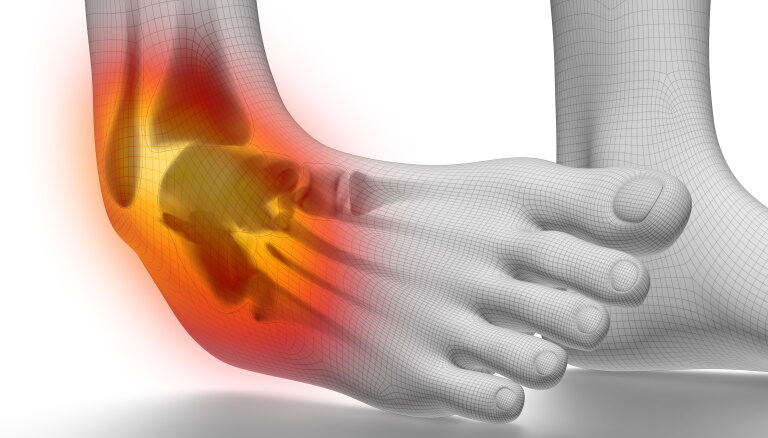
Ankle ligament injuries occur most commonly while participating in sports. However, walking in a high heeled shoe or tripping off of a step can often cause a twisting to the ankle, causing injury to one or more of the ligaments in the ankle joint.
When injuries occur it is important for these ligaments to heal appropriately so that chronic pain and instability do not develop. It is especially important in young teenagers and athletes who want to participate in sports without the ankle constantly giving way.
GRADE I (MILD): Stretching injury to the ligaments causing pain, mild swelling, tenderness and mild pain when walking.
GRADE I (MILD) TREATMENT: Rest, ice, and ankle brace.
GRADE I (MILD) PROGNOSIS: Excellent, full recovery expected within 4-6 weeks.
GRADE II (MODERATE): Partial tearing of the ligament causing pain, moderate swelling, tenderness and it is difficult to bear weight without pain.
GRADE II (MODERATE) TREATMENT: Rest, ice, immobilization in boot or cast and physical therapy.
GRADE II (MODERATE) PROGNOSIS: Excellent. Full recovery is expected with physical therapy and bracing.
GRADE III (SEVERE): Complete tear to the ligaments in the ankle joint region. Severe pain with diffuse tenderness, swelling and discoloration to the ankle joint. Difficulty weight bearing is a clue to the severity to the injury.
GRADE III (SEVERE) TREATMENT: Immobilization in a cast for 4 to 6 weeks, followed by physical therapy and ankle bracing to allow a full return to activity.
GRADE III (SEVERE) PROGNOSIS: Excellent with full recovery expected IF the injury is treated IMMEDIATELY and followed with therapy and bracing.
CHRONIC INSTABILITY: The ankle easily twists and rolls over with walking and during sports, causing pain, swelling and stiffness to the ankle.
CHRONIC INSTABILITY TREATMENT: Aggressive physical therapy, and custom ankle bracing.
CHRONIC INSTABILITY PROGNOSIS: Good if the damage that exists is not severe. Surgery may be necessary to reconstruct the ligaments and allow full recovery.
IMPINGEMENT SYNDROME: Swelling in the ankle joint that becomes chronic due to a history of ankle sprains or fracture. Stiffness in the ankle is present in the morning or after getting up from sitting that loosens with walking but low grade pain still persists.
IMPINGEMENT SYNDROME TREATMENT: Medication, therapy, and bracing for mild injuries. Arthroscopic surgery may be necessary to adequately alleviate symptoms.
We’re here to help! Contact our friendly staff and connect with our expert doctors
The most immediate and noticeable symptom, often sharp and intense. Pain typically worsens with weight-bearing activities and eases with rest
Swelling around the ankle joint is common following a ligament injury, often appearing quickly after the injury occurs
Bruising can develop soon after the injury, indicating underlying tissue damage
Difficulty moving the ankle through its normal range of motion, often due to pain or swelling
A feeling of the ankle giving way or being unsteady, particularly when standing or walking, can indicate a more severe ligament injury
At the time of injury, some individuals may hear or feel a popping or snapping sensation, which often indicates a significant ligament tear
Tenderness to touch around the affected area
Stiffness in the ankle, especially after periods of inactivity or in the morning
Challenges with walking, standing, or bearing any weight on the affected ankle
We’re here to help! Contact our friendly staff and connect with our expert doctors
We treat feet podiatry has been proud to serve the Maryland area’s Foot & Ankle needs for over 30 years! From bunions to twisted ankles to diabetic wound care and everything in between.
Our experienced team is dedicated to get you back on feet again!